RICE (Oryza sativa L.)
Rainfed Farming
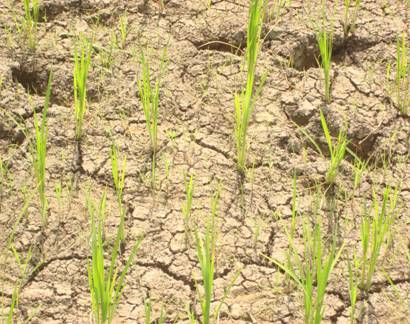
DRY SEEDED RAINFED UN-PUDDLED LOWLAND RICE
RAINFED RICE
The crop establishment, growth and maturity depend up on the rainfall received. There will be standing water after crop establishment for a minimum period of few days to a maximum up to grain filling, depending up on the rainfall. This type of cultivation in Tamil Nadu is called as ‘rainfed rice’, with the assumption that the soil moisture will be under unsaturated (dry) condition during establishment or entire growth period, with reference to tropical climate.
- Seed hardening with 1% KCl for 16 hours (seed and KCl solution 1:1) and shade dried to bring to storable moisture. This will enable the crop to withstand early moisture stress.
- On the day of sowing, treat the hardened seeds first with Pseudomonas fluorescens 10g/kg of seed and then with Azophos 2000g or Azospirillum and Phosphobacteria @ 600g each per ha seed, whichever is available.
- Drill sow with 20 cm inter row spacing using seed drill.
- The seeds can also be sown behind the country plough
- Depth of sowing should be 3 - 5 cm and the top soil can be made compact with leveling board.
- Pre-monsoon sowing is advocated for uniform germination.
- Spray Cycocel 1000 ppm (1 ml of commercial product in one lit. of water) under water deficit situations to mitigate ill-effects.
- Foliar spray of Kaolin 3% or KCl 1% to overcome moisture stress at different physiological stages of rice.
- Foliar spray of 1% urea + 2% DAP + 1%KCl at PI and 10 days later may be taken up for enhancing the rice yield if sufficient soil moisture is ensured.
DRY SEEDED RAINFED UN-PUDDLED LOWLAND RICE WITH
SUPPLEMENTAL IRRIGATION
Semi dry rice
It is called as semi-dry rice. Crop establishment is as that of rainfed rice but the rain water collected in village tank (Kanmai) is supplemented to protect the crop during peak vegetative and reproductive phases. Interaction between applied nutrients and crop is positive here due to better moisture availability than rainfed rice and hence varieties may be improved ones and nutrient levels may be higher than the previous system.
- Spray Cycocel 1000 ppm (1 ml of commercial product in one lit. of water) under water deficit situations to mitigate ill-effects.
- Foliar spray of Kaolin 3% or KCl 1% to overcome moisture stress at different physiological stages of rice. .
- Foliar spray of 1% urea + 2% DAP + 1%KCl at PI and 10 days later may be taken up for enhancing the rice yield if sufficient soil moisture is ensured
DRY SEEDED IRRIGATED UN-PUDDLED LOWLAND RICE
Also be called ‘semi-dry rice’
It is a contingent plan to command areas, anticipating the release of water; rice crop can be established under rainfed condition up to a maximum of 45 days as that of previous two situations. Filed is converted to wet condition on receipt of canal water. Conversion depends up on receipt of canal water and nutrient management is decided according to the period of irrigation.
- Dry plough to get fine tilth taking advantage of rains and soil moisture availability.
- Seed rate: 75kg/ha dry seed for any recommended variety.
- Seed hardening with 1% KCl for 16 hours (seed and KCl solution 1:1) and shade dried to bring to storable moisture. This will enable the crop to withstand early moisture stress.
Other special cultural practices
- Spray Cycocel 1000 ppm (1 ml of commercial product in one lit. of water) under water deficit situations to mitigate ill-effects.
- Foliar spray of Kaolin 3% or KCl 1% to overcome moisture stress at different physiological stages of rice.
- For delayed water release in LBP area, irrigating rice to 5cm depth three days after disappearance of pounded water and growing ADT 38 rice can be resorted to if the release of water is delayed up to September.
MILLETS
SORGHUM (Sorghum bicolor)
Direct sown crop
Seed hardening ensures high germination. The seeds are pre-soaked in 2% potassium dihydrogen phosphate solution for 6 hours in equal volume and then dried back to its original moisture content in shade and are used for sowing.
i) Harden the seeds with 1% aquous fresh leaf extract of Prosopis juliflora and pungam, (Pongamia pinnata) mixed in 1:1 for 16 hrs at 1:0.6 ratio (Seed and solution) followed by drying and subsequently pelleting the seeds with Pungam leaf powder @300 g/kg with gruel.
ii) Halogenise the seeds containing CaOCl, CaCO3 and arappu leaf powder @ 5:4:1 ratio or iodine based (containing 2 mg of Iodine in 3 g of CaCO3) formulation @ 3g/kg packed in polylined cloth bag to maintain seed viability for more than 10 month.
iii) Soak the seeds in 2% (20 g in one litre of water) potassium dihydrogen phosphate or 500 ppm of CCC (500 mg in one litre of water) for six hours and shade dry the seeds for 5 hours. Use 350 ml of solution for soaking one kg of seed.
- Treat the seeds with three packets of azospirillum (600 g) and 3 packets of phosphobacteria or 6 packets of Azophos (1200 g/ha). In the main field, apply 10 packets of azospirillum 2000 g/ha and 10 packets (2000g/ha) of phosphobacteria or 20 packets of Azophos (4000 g/ha) with phosphobacteria 2 kg with 25 kg FYM + 25 kg soil.
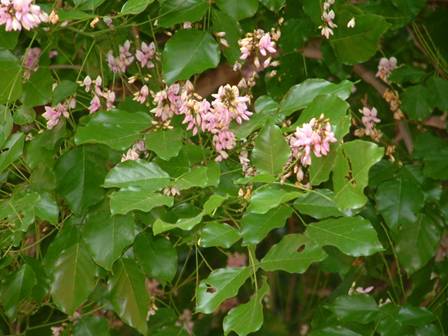
Pongam leaf
www. bengaloorubanter.blogspot.com
Spraying 3% Kaolin (30 g in one litre of water) during periods of stress will mitigate the ill effects.
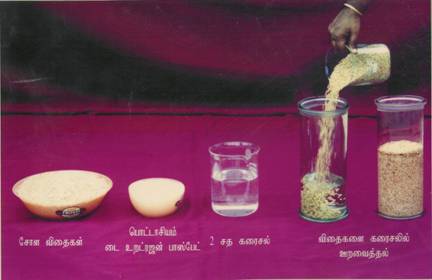
CUMBU (Pennisetum glaucum (L) R. Br.)
To conserve soil moisture under rainfed condition, sow the seeds in flat and form furrows between crop rows during intercultivation on third week after sowing.
RAGI (Eleusine coracana)
The procedure of seed hardening technique is as follows.
- Soak seeds in water for 6 hours. Use one litre water for every kg seed for soaking.
- Drain the water and keep the seeds in wet cloth bag tightly tied for two days.
- At this stage, the seeds will show initial signs of germination.
- Remove seeds from the wet cloth bag and dry them in shade on a dry cloth for 2 days.
- Use the above hardened seeds for sowing.
COWPEA ( Vigna unguiculata (L.) Walp.aggreg.)
Spraying Of Diammonium Phosphate Or Urea, Naa And Salicylic Acid
a. Foliar spray of Spray of NAA 40 mg/litre and Salicylic acid 100 mg/litre once at pre-flowering and another at 15 days thereafter
b. Foliar spray of DAP 20 g/litre or urea 20 g/litre once at flowering and another at 15 days thereafter
GROUNDNUT (Arachis hypogaea )
POLYTHENE FILM MULCHING
Spread black polythene sheet over the soil surface. Seven micron polythene film sheet @50 kg/ha is required. Holes can be made at required spacing before spreading of the sheets.
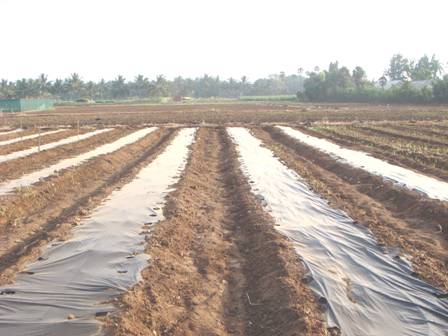
SESAME (Sesamum indicum)
SPRAYING NAA
- Spray the hormone Napthalene Acetic Acid (NAA) at 20 ppm concentration (280 g NAA in 625 litres of water per ha) on the 30th and 60th day of sowing.
- Use a high volume sprayer and give a thorough coverage of the entire plant.
- Do not use brackish water.
COCONUT (Cocos nucifera)
Drought management and soil moisture conservation
a. Mulching with coconut husks/leaves/coir pith
Apply coconut husks with convex surface facing upwards (100 Nos.) or dried coconut leaves (15 Nos) or coir pith up to a height of 10 cm in the basin of 1.8 m radius around the palms as mulch for soil moisture conservation particularly during summer season.
b. Burial of coconut husk or coir pith
Husk burial can be done in coconut basins or in the interspaces to overcome drought and button shedding. Bury husks @ 100 Nos. with concave surface facing upwards or 25 kg of coir pith /palm in circular trenches, dug 30 cm width and 60 cm depth at 1.5 metres radius. The husk can be also buried in the trenches at a distance of 3 m from the palm with a size of 45 cm deep and 150 cm width in between two rows of coconut. The soaking of the coconut husk or coir pith as the case may be preserves the monsoon rains.
c. Manuring
From 5th year onwards, apply 50 kg of FYM or compost or green manure. 1.3 kg urea (560 g N), 2.0 kg super phosphate (320 g P2O5) and 2.0 kg muriate of potash (1200 g K2O) in two equal splits during June – July and December – January. Apply manures and fertilizers in circular basins of 1.8 m from the base of the palm, incorporate and irrigate. During 2nd, 3rd and 4th year ¼, ½ and ¾ doses of the above fertilizer schedule should be adopted respectively. Sufficient moisture should be present at the time of manuring. Fertigation may be done at monthly intervals with 75% of the recommended dose of the above fertilizers. Phosphorous may be applied as super phosphate in the basins and incorporated or as DAP through drip when good quality of water is available.
COTTON ARRESTING TERMINAL GROWTH:
Nip the terminal portion of the main stem as indicated below:
For varieties having less than 160 days duration nip the terminal portion of the main stem beyond the 15th node (75 to 80 DAS) and for varieties and hybrids having more than 160 days duration beyond the 20th node (85 - 90 DAS).
RAINFED COTTON
Follow water harvesting techniques and raise a successful crop of cotton.
SUGARCANE (Saccharum officinarum)
Contingent plan
Gradual widening of furrow:
At the time of planting, form furrow at a width of 30 cm initially. After that, widen the furrow to 45 cm on 45th day during first light earthing up and subsequently deepen the furrow on 90th day to save 35% of water.
Drought Management:
- Soak the setts in lime solution (80 kg Kiln lime in 400 lit) for one hour.
- Plant in deep furrows of 30 cm depth.
- Spray potash and urea each at 2.5 per cent during moisture stress period at 15 days interval.
- Spray Kaolin (60 g in 1 ltr. of water) to alleviate the water stress.
- Under water scarcity condition, alternate furrow and skip furrow method is beneficial.
- Apply 125 kg of MOP additionally at 120 day of planting.
- Basal incorporation of coir waste @ 25 tonnes/ha at the time of last ploughing.
- Removal of dry trash at 5th month and leave it as mulch, in the field.
TRASH MULCHING
Mulch the ridges uniformly with cane trash to a thickness of 10 cm within a week after planting. It helps to tide over drought, conserves moisture, reduce weed population and minimise shoot borer incidence. Mulch the field with trash after 21 days of planting in heavy soil and wetland conditions. Avoid trash mulching in areas where incidence of termites is noticed
.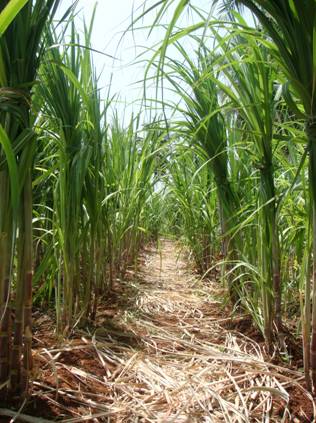
|





